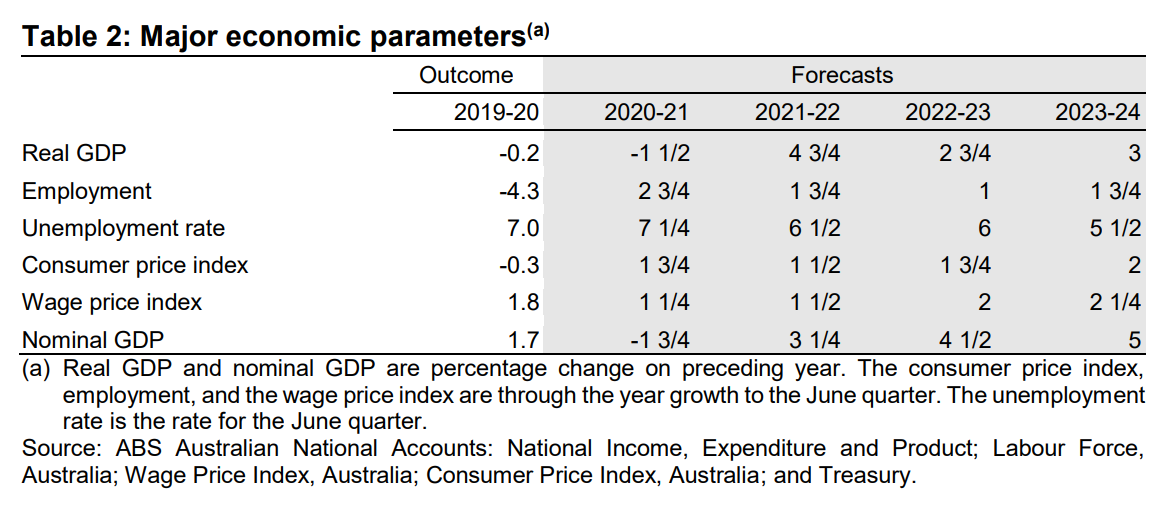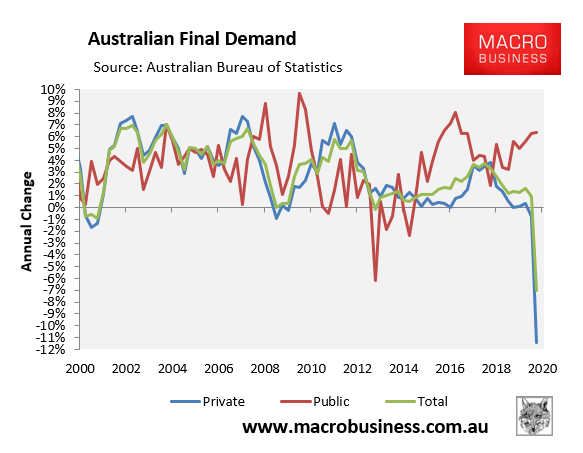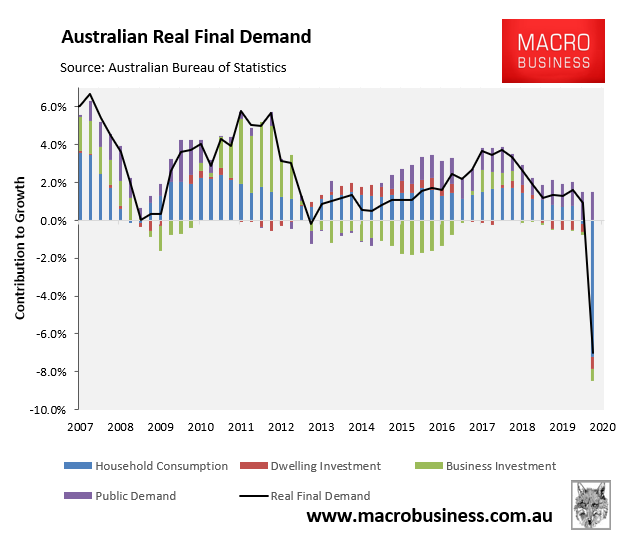Tonight’s Federal Budget delivered by Treasurer Josh Frydenberg was a dull affair that lacked ambition and included no real surprises.
As expected, the Budget deficit is projected to balloon:

However, the economic projections are rose coloured, with growth projected to bounce back strongly alongside a magical gradual return to trend unemployment by 2023-24:

Turning to the actual budget measures, there was little that hadn’t already been announced. Below are the key announcements.
JobMaker hiring credit
As announced prior, a new JobMaker hiring credit will be provided to businesses (other than the major banks) that hire younger Australians aged 16-35.
It will be paid at the rate of $200 per week for those aged under 30 and $100 per week for those aged between 30-35, provided they are employed for at least 20 hours a week.
Treasury estimates that this will support around 450,000 jobs for young people.
As MB noted on Tuesday, this scheme will likely be rorted en masse and will likely result in businesses shifting their wage bills onto taxpayers, not in more employees, with owners pocketing the extra profits.
On the positive side, the Budget also announced an additional $1.2 billion to create 100,000 new apprenticeships and traineeships, with a 50% wage subsidy for businesses who employ them.
This is good policy as it will help to arrest the collapse in apprenticeship numbers and funding over the past decade, and will provide much-needed training for younger Australians in areas of the economy experiencing genuine skills shortages.
Tax cuts
As already flagged, the Budget will bring forward Stage Two of the legislated tax cuts by two years, lifting the 19% threshold from $37,000 to $45,000, and lifting the 32.5% threshold from $90,000 to $120,000.
These tax cuts will also be backdated to 1 July this year, thereby providing 11 million taxpayers with extra disposable income, with more than 7 million Australians receiving tax relief of $2,000 or more this year.
The Low and Middle Income Tax Offset will also be extended for an additional year.
While MB does not oppose the Stage Two tax cuts, we also believe that it won’t do much to stimulate the economy, given most of the income will be saved rather than spent.
Business Investment Incentives
Small, medium and larger businesses with a turnover of up to $5 billion until June 2022 will be permitted to write-off the full value of any eligible asset they purchase for their business, with the goal to stimulate sagging business investment.
Infrastructure
The Budget announced an additional $2 billion of investment into road safety upgrades, alongside an additional $1 billion to support local councils’ immediate upgrades of local roads, footpaths and street lighting.
Regions and environment:
Key measures to support Australia’s regions and environment include:
- $2 billion in concessional loans to help farmers overcome drought
- $350 million to support regional tourism to attract domestic visitors
- $317 million for Australian exporters to access global supply chains
- $2 billion in new funding to build water infrastructure across the country
- $1.8 billion in funding for the environment
- $250 million to modernise our recycling infrastructure
Housing
As already announced, an additional 10,000 first home buyers will be able to purchase a new home sooner under the First Home Loan Deposit Scheme. This comes on top of the 20,000 places already offered.
An additional $1 billion of low cost finance to support the construction of affordable housing was also announced.
NDIS
An additional $3.9 billion will be provided for the NDIS.
Seniors
Aged Pensioners will receive an additional $250 payment from December and a further $250 payment from March next year.
23,000 additional home care packages will also be provided to senior Australians who want to keep living at home, at a cost of $1.6 billion.
National Security
An additional $450 million will be provided for law enforcement and intelligence agencies to counter foreign and domestic threats.
Initial Impression – Where’s the Demand Stimulus?
In normal times, I would not have any major concerns with this budget. It is a fairly conservative affair with not too much pork, save for some excessive wage subsidy giveaways to business.
The problem is, these are not normal times. This is the biggest economic contraction since the 1930s Great Depression. And viewed in this light, the budget badly lacks ambition.
What stimulus there is focuses on the supply-side at a time when Australia already faces a gigantic output gap and excess capacity everywhere.
Meanwhile, the budget contains no meaningful measures to stimulate demand, which has collapsed:


It should have included measures that boost income support to the unemployed (e.g. by permanently lifting JobSeeker), as well as provided traditional Keynsian stimulus via big investments in public building works and infrastructure, among other things.
Because of these oversights, the Australian economy will face a longer and deeper downturn than necessary with stubbornly high real unemployment, widespread business failures, and increased homelessness.
The best the Australian economy can now hope for is a slow, low-wage, part-time recovery.

